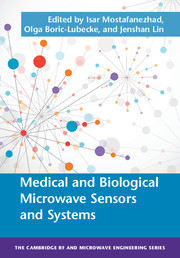Book contents
- Frontmatter
- Contents
- Contributors
- 1 Implantable Wireless Medical Devices for Gastroesophageal Applications
- 2 Embedded Wireless Device for Intracranial Pressure Monitoring
- 3 Wireless Intracranial Pressure Systems for the Assessment of Traumatic Brain Injury
- 4 Microwave Biosensors for Noninvasive Molecular and Cellular Investigations
- 5 Wearable Radar Tag Systems for Physiological Sensing/Monitoring
- 6 Physiological Radar Sensor Chip Development
- 7 Noise- and Interference-Reduction Methods for Microwave Doppler Radar Vital Signs Monitors
- 8 Biomedical Applications of UWB Technology
- Index
- References
6 - Physiological Radar Sensor Chip Development
- Frontmatter
- Contents
- Contributors
- 1 Implantable Wireless Medical Devices for Gastroesophageal Applications
- 2 Embedded Wireless Device for Intracranial Pressure Monitoring
- 3 Wireless Intracranial Pressure Systems for the Assessment of Traumatic Brain Injury
- 4 Microwave Biosensors for Noninvasive Molecular and Cellular Investigations
- 5 Wearable Radar Tag Systems for Physiological Sensing/Monitoring
- 6 Physiological Radar Sensor Chip Development
- 7 Noise- and Interference-Reduction Methods for Microwave Doppler Radar Vital Signs Monitors
- 8 Biomedical Applications of UWB Technology
- Index
- References
Summary
Theory and Recent Advancements
Using radar to detect small physiologic signals such as respiration and heartbeat dates back to the 1970s [1]. It was realized by detecting the change in carrier phase or the round-trip time of flight (RTOF) in the received radar signals that is caused by the physiologic motion of the human body. The fundamental principle is similar to that in the radar guns that detect the speed of vehicles. Based on the format of transmit signal, there are two basic types of radars: continuous-wave (CW) radar and pulse radar. CW radar falls into two subcategories: single tone, which is mostly operated in interferometry mode, and frequency-modulated CW (FMCW), which sends out a chirp signal with the carrier frequency dynamically changing in time domain. Each category of radar has its specific advantages. Single-tone CW radar has a simple system architecture that allows high-level chip integration. It can also easily achieve high accuracy (submillimeter) in relative displacement measurement. FMCW radar is able to detect the absolute distance between the radar source and the subject, which is referred to as range information. Researchers also have successfully integrated FMCW radar on a chip. Recently, a hybrid radar system combining the advantages of single-tone and FMCW radar was reported by Wang et al. [2]. Pulse radar, which is usually accompanied by ultra-wideband (UWB) characteristics, has very high special resolution due to its large-wideband nature [3]. The integration of UWB radar is also reported for noncontact physiologic sensing.
A generalized setup of radar noncontact physiologic sensing is shown in Figure 6.1. To detect physiologic signals, the system usually consists of a waveform generator, a radiofrequency (RF) front end, baseband signal conditioning blocks, an analog-to-digital convertor (ADC), and a signal-processing unit. The radar-generated signal is transmitted toward the human subject, where it is modulated by the physiologic motion and partially reflected. The radar receiver captures the received signal, down-converts it into baseband, and sends the digitized signal to the signal-processing unit to extract physiologic motion information, from which important vital signs such as heartbeat, respiration, or even blood pressure can be derived.
Operation of CW Physiologic-Sensing Radar
The basic CW radar configuration normally transmits a single-tone RF signal (f 0) toward the human subject, as shown in Figure 6.2. The received signal will maintain the same frequency of f 0, but with a phase shift accumulated along the signal path.
- Type
- Chapter
- Information
- Medical and Biological Microwave Sensors and Systems , pp. 172 - 201Publisher: Cambridge University PressPrint publication year: 2017



